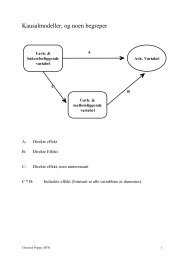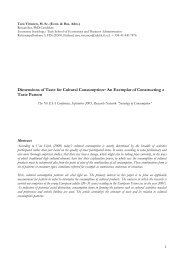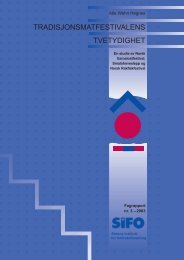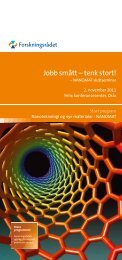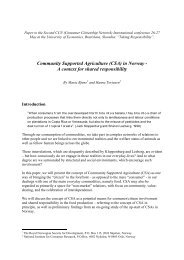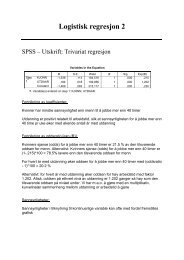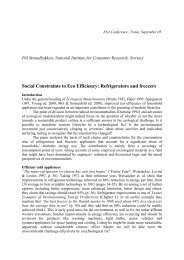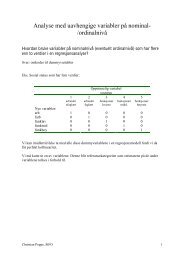Rapport nr - SIFO
Rapport nr - SIFO
Rapport nr - SIFO
- No tags were found...
Create successful ePaper yourself
Turn your PDF publications into a flip-book with our unique Google optimized e-Paper software.
32roir® store brands changed the organisation of prices on local food. Store brands are always cheaperthan national brand for most products commercialised in these large stores. The association between alabel and an appellation raises the price of local products. This is also the case between a Terroir®store brand in association with a label and a national brand without a label or appellation. A study ofHassan & Monier-Dilhan underlines this fact and which price consumers are willing to pay for a nationalbrand or a store brand with or without a label. The store brands allow a large distribution areafor their products, not only for the region of production but also for the whole of France and exportation.To advertise, store brands prefer to communicate about the brand rather than about the product,which allows, for example, “Reflets de France” to use one advertisement for more than 300 productsand they can share the price of promotion in each product. The cost of communication per product,often more than 20% of the total price, is reduced and allows store brands to be cheaper than normalbrand.French consumers are not always ready to pay more for quality. A study by the CREDOC (Centre ofResearch for the Study and the Observation of life Conditions)-INC (National Institute for Consumption)in 2001 reveals that consumers with a low purchase power are not ready to pay more for healthrisk or quality. This is not surprising, but it is interesting when we analyse the types of products forwhich consumers are ready to pay more. For example, some consumers will pay more for a qualitylabel in meat (75% of consumers interviewed agree to pay more a quality assurance label) or poultry(71% of consumers interviewed agree). Concerning eggs and cheese, only the half of consumers areready to pay more for a quality signs, and only 30% for milk. The high consumption of labelled poultryseems to support these results.Concerning prices, as we can see with the example of the PDO Ossau-Iraty and the brand Etorky(which doesn’t use the PDO), and Etorky is more expensive than the “traditional PDO product”, Ossau-Iraty.To understand this difference we have to look at the beginning of this PDO and the interactionbetween the brand Etorky and the Union managing the PDO. In 1980, there were three regionswhich produced sheep milk, Aveyron, Corsica, and South West. The most Important Company manufacturingsheep cheese was Roquefort and Lactalis, in Aveyron. Roquefort bought the milk also in theSouth West to produce its cheese. Those Producers who have more independence and a better valorisationof their products choose to create a new PDO, l’Ossau-Iraty based on traditional know how ofthis region (grouping two valleys of two different departments). The creation of this PDO was an initiativeof producers but also of a big company member of Bongrain Group. At the beginning Bongraincommercialized their product with the PDO but after a short time they noticed that with a brand managementand not only a global PDO promotion, they could raise the valorisation of their product. Afterfew years, Etorky, the brand of Bongrain a competitor company of Lactalis was better known than thePDO Ossau-Iraty and its price was also higher (16€/kg for Etorky and only 13€/kg for the traditionalPDO). Moreover, the participation and the financing of the PDO appeared too high for Bongrain , aswell as the conditions of the PDO too strict to have a brand management: they could then left the PDOUnion, their brand was sufficient to sell their product but they don’t want to leave the PDO becausefor us it can represent a good way to buy quality milk directly with the producers of the Union. In thiscase the brand management and the strength of an international brand allowed being more efficient inthe creation and the valorisation of this new product.




